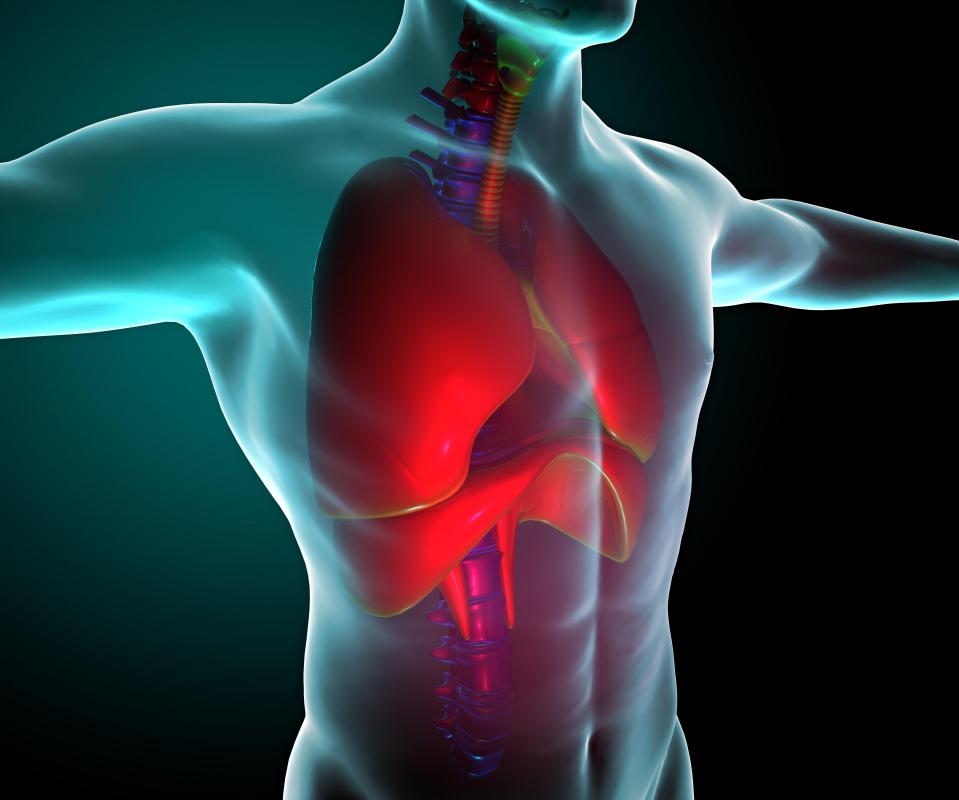At TheHealthBoard, we're committed to delivering accurate, trustworthy information. Our expert-authored content is rigorously fact-checked and sourced from credible authorities. Discover how we uphold the highest standards in providing you with reliable knowledge.
What is an Elevated Hemidiaphragm?
Elevated hemidiaphragm is a condition in which half of a patient's diaphragm appears to be raised or elevated. It can be seen on a medical imaging study or upon surgical examination, and it is an indicator of a serious health problem. The treatment for elevated hemidiaphragm varies, depending on what is causing the situation, and may require input from several medical specialists who can combine forces to develop the most appropriate and effective treatment.
The diaphragm is a tough layer of tissue which plays a role in respiration and separates the thoracic cavity from the abdominal cavity. The tissue is designed to move with respiration to accommodate the expansion and contraction of the chest which occurs when people breathe in and out. Problems with the diaphragm can inhibit respiration and cause other medical issues for patients.

There are three possible reasons for half of the diaphragm to appear raised or elevated: something wrong with the diaphragm itself, something going on in the abdomen which is pushing this tough sheet of tissue up into the chest, or something occurring above the level of the diaphragm which is causing the diaphragm to float upwards.
One reason for elevated hemidiaphragm may be that half the diaphragm has been paralyzed by nerve damage. Another reason is cancer; if a cancer intrudes into the diaphragm, it can be pulled out of position. Patients with lung cancer are at particular risk of this, as the lungs are close to the diaphragm and it is easy for the cancer cells to make the leap to the diaphragm.

Raised or elevated hemidiaphragm can also be caused by a buildup of fluid in the abdomen, a tumor, a surgical complication, or a cyst below the diaphragm. Causes from above can include the collapse of a lung or broken ribs, which destabilize the structure of the rib cage and may pull the diaphragm out of position.
When a patient presents with elevated hemidiaphragm, the first step is figuring out why the condition is occurring, while keeping the patient comfortable if discomfort is being experienced. Medical imaging, patient interviews, and other diagnostic techniques can be used to learn more about the situation. Once a cause is identified, it can be treated, and in the process the elevated hemidiaphragm should be resolved as well. Treatment options can include surgery to drain cysts or remove tumors, chemotherapy to shrink cancers, and so forth.
AS FEATURED ON:
AS FEATURED ON:















Discussion Comments
An old recollection I have not seen mentioned in articles on the Net is Any abnormal bleeding may be a sign of cancer in the body, like bleeding into the skin. A recent case of this and a failure to properly diagnose possible or even probable lung cancer-which then proved fatal due to it not being followed up causes me to try to recall any such possible signs which may be helpful to others. A positive diagnosis as early as possible may save a life.
What does one do when the X-ray shows elevated right hemidiaphragm with associated volume loss and airspace opacification jn the right to mid lower zones etc and no further treatment or investigation done?
In fact, these features were ignored in the diagnosis and the patient sent home. They were back in seven months, and the X-ray, bronchioscope and biopsy showed stage 4 lung cancer. No treatment again, no TPN, let starve, MDs did nothing. Answer: die.
I am a 62 year old angioplasty patient which was performed on me when I was 39 years of age.
Very recently a CT thorax was performed due to a chest infection and showed that while my lungs are clear, no pleaural effusion was noted and no other gross abnormality in the chest and upper abdomen detected, there is a high position of the RT hemidiaphragm. This RT hemidiaphragm is constant and consistent when compared to other X-rays I've had in the past.
I do treadmill exercises for 40 minutes each day and I do not experience any chest pains or loss of breath and blood pressure and glucose tests are good.
The doctors at the hospital told me I shouldn't worry and they ordered a repeat chest X-ray in six weeks time.
However after reading your articles, I have started to worry a bit. Should I worry and should I do further tests? I thank you for your advice.
Ray, Malta
Can degenerative disc cause elevated hemidiaphragm?
I have a hemidiaphragm after a VATS debridment for empyema. I have been signed off from my surgeon. I am struggling to breath when climbing stairs or walking faster then a normal stroll. I have to stop and wait a few minutes for my breathing to slow to a normal pace. Can anyone help me with excises I can do to improve this?
I had my gallbladder removed earlier this year. Wwo and a half weeks after the surgery, I woke up one morning and I felt I wasn't getting 100 percent oxygen into my lungs. I have been through many tests. My bloodwork is normal, as is my sniff test. No paralyzed diaphragm, my heart was healthy on the echocardiogram, no blocked arteries, no asthma and my lung oxygen saturation is normal. The pulmonologist did note a thin band of atelectasis at bottom of each lung and the person doing my asthma testing a couple of weeks noted the right diaphragm was sitting a bit higher than the left one after looking at my X-ray.
After surgery, I was up and walking around constantly (afraid to get clots, and to get any air out of my system). I don't recall being told to keep doing deep breathing exercises.
Ten weeks later I have persistent shortness of breath day and night, not one day off, not even five minutes relief. I was told I wasn't in a life or death situation because I'm getting normal oxygen levels into my lungs at rest and on exertion. I find though, that the breathing seems to intensify throughout the day (even though it really isn't) and that the upper abdomen and ribs tighten at times, and my throat feels sore. This is wearing me down mentally.
Could this be due to both the diaphragm and atelectasis? I see the pulmonologist's assistant in another few days to go over test results and I guess to see next plan of action. Any thoughts? Thanks.
My husband had a double bypass opp the end of last month afterwards he had an x ray and was diagnosed with a high diaphragm to his right side. This is making him even more breathless than before heart surgery. This had not shown on x ray before the operation, but an old x ray from 2005 or 2006 was found to show this.
Could the bypass operation have aggravated the symptoms? Why would it not have shown up on xrays immediately before the operation?
@burcidi-- I think an x-ray is just the first step. I know from my dad that after the x-ray, they did additional x-rays for the chest and something called a fluoroscopy. There were even more tests they could do if they were not able to tell exactly what was causing it, but it wasn't necessary.
So, I guess it depends on the person. A couple of x-rays might be enough for some people. And for others with a more complicated problem, they might do additional testing.
So what kind of tests are necessary to confirm that the hemidiaphragm is raised? Is an x-ray enough?
The body is so interesting. One problem can lead to another which leads to another. I had elevated hemidiaphragm several years ago which was caused by the dilation of my stomach. It turns out the dilation was caused by anemia. When my anemia was treated, the other problems went away along with it.
I think the body has many different ways of warning us about a deeper underlying problem. Elevation of the hemidiaphragm is one of them. If it's there, it means there is something else going on.
can surgery for robotic prostate removal where a person is elevated during surgery for six hours cause an elevated hemidiaphragm?
Post your comments